
24/7 fans are the new standard fans of the sports world. They want to access your sports organization and your content whenever they want and wherever they are. But this of course can seem easier said than done. Or is it?
In this blog post, we will be covering:
- What exactly we mean by the 24/7 fan
- What the 24/7 wants and desires from sports organizations
- A challenge to delivering on these wants and desires
- How sports organizations can adapt and deliver what 24/7 fans want
So without further ado, let’s jump right into the blog post.
Before we dive right in...
Subscribe to our blog today to ensure that you never miss valuable posts such as this one. We are passionate about helping sports organizations deliver a world-class fan experience, because better fan experience means better business. So why not use this opportunity to the fullest?

The 24/7 fan is now the standard
In this day and age, it’s no secret that consumer behaviors have changed as a result of digitalization. And this is no exception for sports fans. From attending live games and watching via traditional tv broadcasting being the standard, today’s fans now have a new standard. And that is having a 24/7 experience. This expectation is, of course, enabled partly by mobile devices, tablets, and 4G. Fans literally have access to the world from the palm of their hands. And so sports organizations need to adapt to these expectations.
Just check out the stat below showing ESPN’s audience where 2/3 are exclusively mobile.
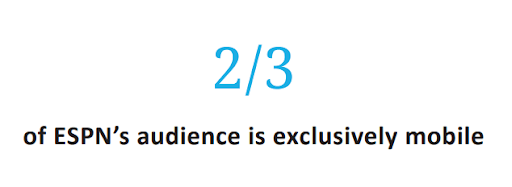
Although this stat is just one example, the trend of fans being mobile can be seen across the entire sports industry and beyond. According to Performance Marketing and Canvas8, around 18% of big sporting event searches were made from mobiles in 2010. Then already in 2014, this number increased to 63%.
As you can see, mobile has become the new standard for how fans interact with sports content and organizations.
So what exactly do fans want to see and experience?
What the 24/7 fan wants
To answer the question of what fans want to see and experience when interacting with sports brands, let’s have a look at some of the results of a questionnaire conducted by Performance Marketing and Canvas8.
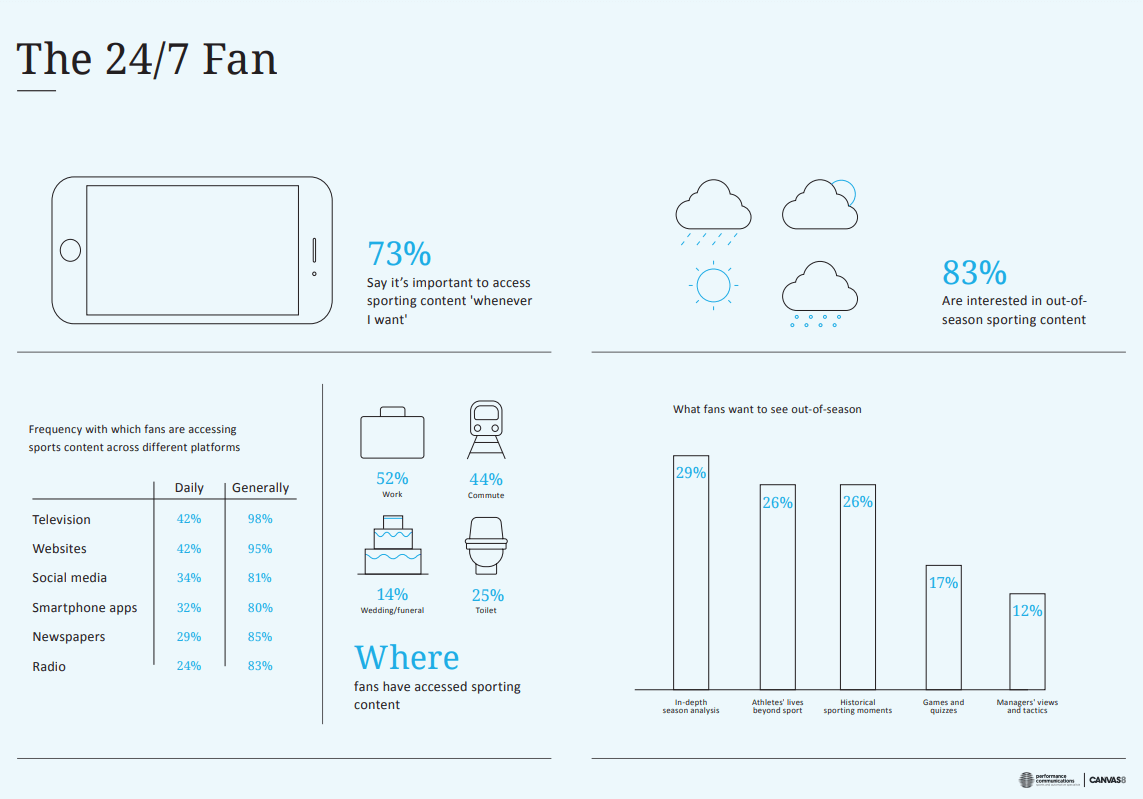
When looking at the results, we can see that:
- 73% said that it is important to them to access sports content “whenever they want”
- When asked about the frequency of accessing sports content, aside from television, newspapers, and radion, fans would access sports content on a daily basis via:
- Website of sports organizations (42%)
- 34% via social media
- 32% via smartphone apps
- 83% said that they are interested in off-season sports content
- And when asked what type of content they want to see off-season, the top three content types were:
- In-depth analyses
- Athletes’ lives beyond sports
- Historical sporting moments
So what do these results tell us about today’s sports fans? Well, they tell us that fans not only prefer to watch sports differently. They also want to watch different types of sports content that they used to. They want to receive experiences beyond live games and the stadium. And they want access to these experiences 24/7. But can’t sports organizations just adapt and give their fans these experiences? Yes, but there is a challenge that first needs to be addressed before sports organizations can actually deliver any of this.
And it all comes down to something all sports organizations have but need to know how to leverage.
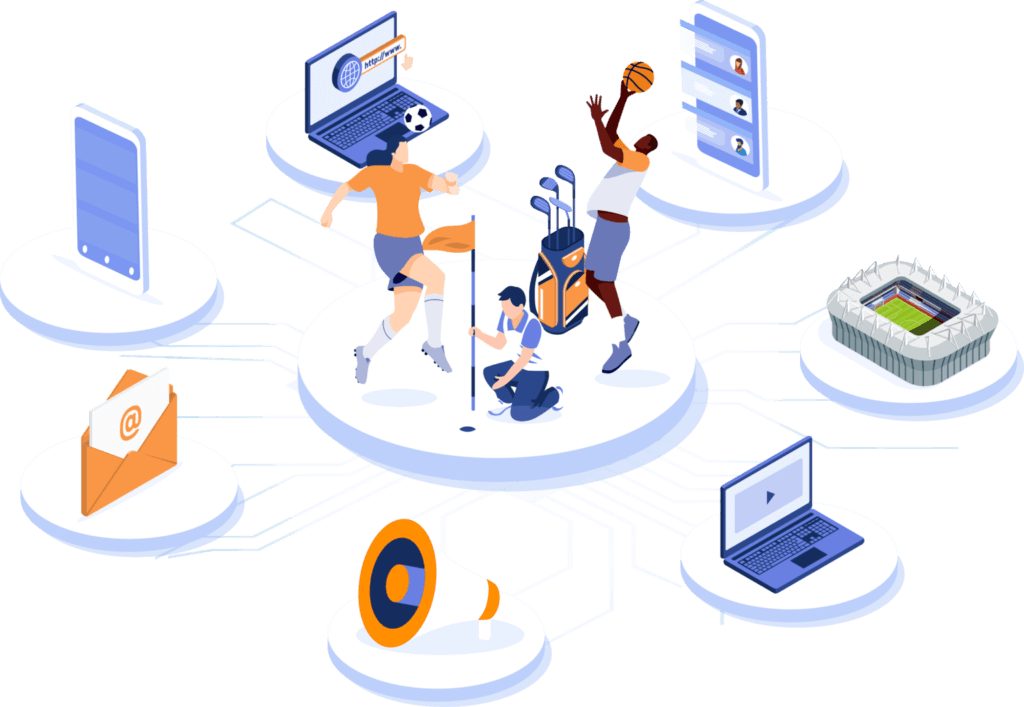
The challenge and the opportunity
So what exactly do we mean by the challenge? To answer this question, let me ask another one first:
If you want to deliver on the wants and desires of your fans, how exactly do you know what their wants and desires are? Do you guess? Do you ask them? What do you do?
Now, that was more than one question, but you see my point right? You need to know exactly what your fans want and desire before doing anything else. The great news is that you can find out what your fans want. And that is by having data about each fan’s specific:
- Characteristics
- Preferences
- Behaviors
When you have these insights, you will be able to deliver exactly what they want and when they want it. And the good news is that you already have all of this information available to you. Where exactly? Well, across your different sources, such as:
- Ticketing system
- Point of Sale (POS) system for in-stadium food and beverage purchases
- Online POS or e-commerce system for your merchandise
- Social media platforms
- App
- OTT streaming service platform
- Newsletter and mailing lists
- Event sign-up lists
As you can see, there are so many different sources from which you can collect deep insights about your fans. But do you see the flipside here? That although it is indeed epic that you have access to so much data, the next question that arises is how exactly you will access all of this data. Okay, sure, you could dive right in and start collecting information from each source. One at a time, piece by piece.
Now, how long time would this take? Well, depending on how much data and sources you have, then yeah, you can do the math.
According to Deloitte Digital, the average business has 17 unique technology applications housing customer data.
So what are innovative sports organizations out there doing to tackle this challenge? Well, they are implementing a solution that can solve this challenge. And this solution is none other than a Sports Customer Data Platform, a software that allows you to:
- Collect all of your data from any source that your sports organization has
- Unify it in the platform and gain deep insights about your fans, including a 360-degree view of each fan and their specific characteristics, preferences, and behaviors.
- Based on these insights, the Sports CDP then enables you to act on these insights and deliver content and other communications and interactions to your fans through their preferred channels and mediums.
To see a visualization of the above, check out the below illustration below.
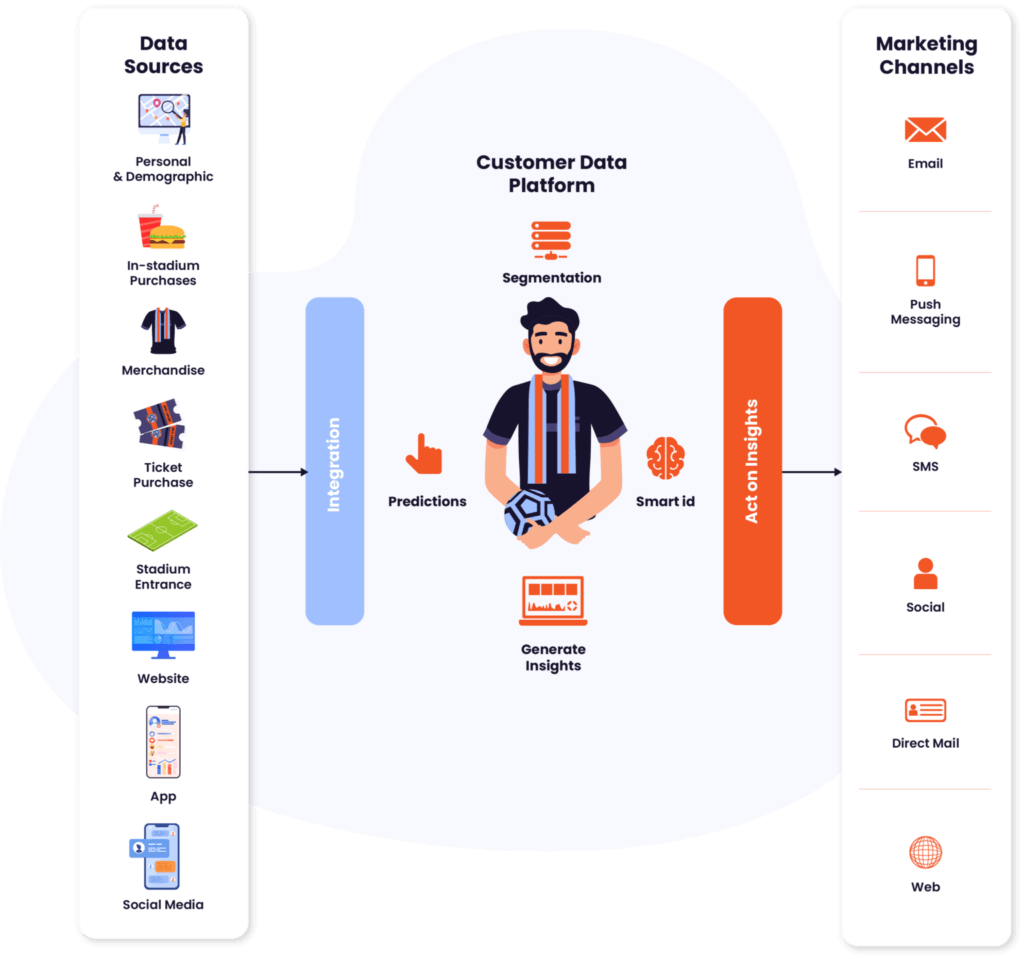
And it doesn’t stop there. Because all of the above happens in real-time. And that several of these processes are automatic. So yes, you save a lot of time. And time is money. Some of the benefits you will reap from using a Sports CDP are:
- Increased overall revenue – optimize your current revenue streams such as ticket sales, merchandise sales, in-stadium purchases, etc.
- Optimized sports marketing spend – thanks to a 360-degree fan view, you can rest assured that you deliver the right message, at the right time, in the fan’s preferred channel.
- Save money, time, and effort – receiving all relevant data about your fan in real-time, centralized in the Sports CDP, will allow you to streamline and optimize.
- Sustainable growth – working data-driven will allow you to replicate the previous benefits in the long-run as well.
- Uncovering new viable revenue opportunities, such as:
- Leveraging Over-the-Top streaming service (OTT) by delivering hyper-personalized ads and content recommendations.
- Opportunities for your women’s division that you uncovered thanks to the data insights about your supporters
- Negotiate higher sponsorship deals by demonstrating how many supporters you have in your database
And it doesn’t stop there. Because all of the above happens in real-time. And that several of these processes are automatic. So yes, you save a lot of time. And time is money. Some of the benefits you will reap from using a Sports CDP are:
- Increased overall revenue – optimize your current revenue streams such as ticket sales, merchandise sales, in-stadium purchases, etc.
- Optimized sports marketing spend – thanks to a 360-degree fan view, you can rest assured that you deliver the right message, at the right time, in the fan’s preferred channel.
- Save money, time, and effort – receiving all relevant data about your fan in real-time, centralized in the Sports CDP, will allow you to streamline and optimize.
- Sustainable growth – working data-driven will allow you to replicate the previous benefits in the long-run as well.
- Uncovering new viable revenue opportunities, such as:
- Leveraging Over-the-Top streaming service (OTT) by delivering hyper-personalized ads and content recommendations.
- Opportunities for your women’s division that you uncovered thanks to the data insights about your supporters
- Negotiate higher sponsorship deals by demonstrating how many supporters you have in your database

Check out this blog post to learn more about why you need a Sports CDP to future-proof your sports organization:
Sports CDP: 5 reasons you need one to future-proof your sports club>>
Adopting a Sports CDP is thus not just a short-term solution but one that secures a profitable future as well.
So now that you know this, let’s have a look at some more concrete examples of what you can do to adapt to the 24/7 fan using a Sports CDP.
How you can adapt to fans’ wants using a Sports CDP
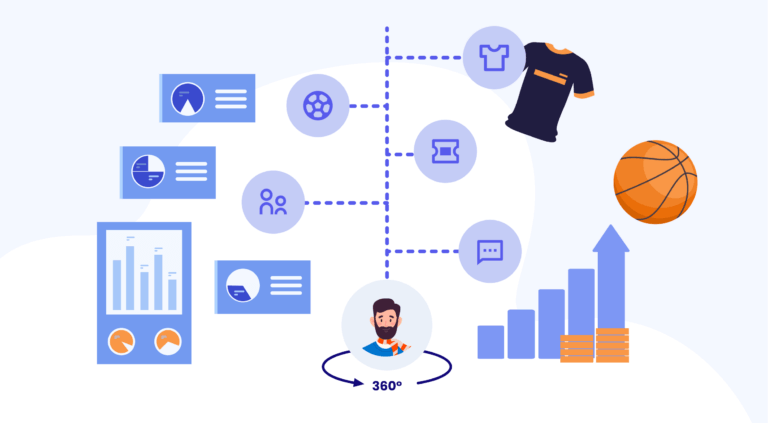
24/7 fan tip 1: Focus on personalization
This is one if not the most important way you can adapt to your 24/7 fans’ wants and desires. Personalization means that you personalize the content and experiences to each fan. It is:
“The process of making something suitable for the needs of a particular person.”
And as we have covered earlier in this blog post, when it comes to your sports organization, there are many channels and platforms where you can deliver hyper-personalized experiences to your fans, such as:
- In-stadium
- Website
- App
- OTT streaming service
- Social media platforms
- Exclusive newsletter
- Community Group
No matter where your fan wants to receive content and experiences, what is important is to once again know what type of content and experiences your fans want to see. And here is where you will need to rely on those insights you collected about your fans, which a Sports CDP can do for you.
To give you an idea of how powerful personalization when done right, check out the success story of AIK below:
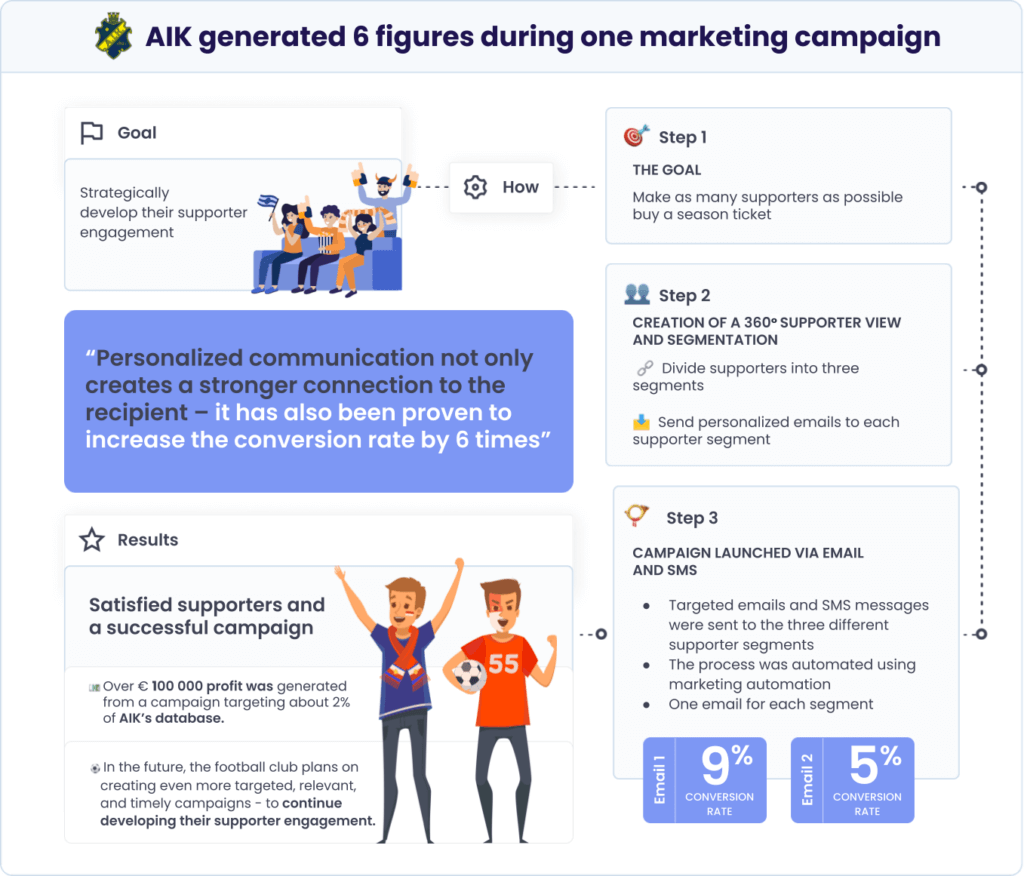
AIK is a football club competing in the top league of Swedish football. They had a goal to increase their supporter engagement. So to achieve this goal:
- AIK leveraged the Data Talks Sports CDP to gain a 360-degree view of each fan and understand their unique characteristics, preferences, and behaviors.
- Once they knew this, they could segment their fans into different groups based on insights about their fans.
- Then, they could target them with hyper-personalized email and SMS campaigns.
What was the outcome? Well, not only did AIK see a surge in supporter engagement, but they also managed to yield €100 000 profits. And they were only targeting 2% of their fanbase!
What does this tell us? Well, it tells us that having enough data insights about your fans can make all the difference in creating and delivering successful, hyper-personalized experiences to your fans.
And you can achieve this too.
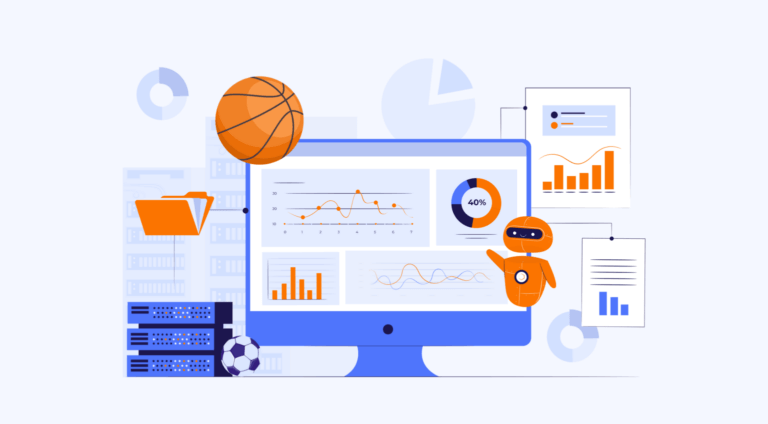
24/7 fan tip 2: Offer Pre-, post-, and off-season content
If you remember the stat we looked at during the beginning of the blog post, then you know that 24/7 fans are interested in sports content beyond live games days. 24/7 fans are now also highly interested in off-season content and other types of content. In fact:
“The day before a live event, fan consumption of sport-related videos increases 75%. With this in mind, content to build pre-game anticipation will proliferate.”
And when it comes to the types of off-season content, the top three content types fans in the same study were in-depth analyses, athletes’ lives beyond sports, and historical sporting moments. But to give you some more examples, other off-season content 24/7 fans are interested in are:
- Player interviews
- Game analysis
- Behind-the-scenes footage
- Pre-recorded extras
- Archived footage
- Player Q&A’s
- Fan-generated content
- Fantasy leagues
- Celebrity endorsements
- Team news
- Exclusive deals
- Offers
- Fans only access
However, although you should indeed deliver this content on your fans’ preferred channels, another trend that is not only becoming increasingly common but actually standard is for sports organizations to have their own digital platforms. And one such owned platform is an OTT platform.
OTT stands for Over-the-top media service and is a platform that your sports organization owns. Here you can broadcast and stream your sports content. Since you own the channel, you will also have much more control over the interactions and experiences you deliver on it. And as you might have guessed, a Sports CDP will enable you to do this in the best way possible.
But let’s move on and take a look at the athletes and how they can help you adapt to the 24/7 fan.
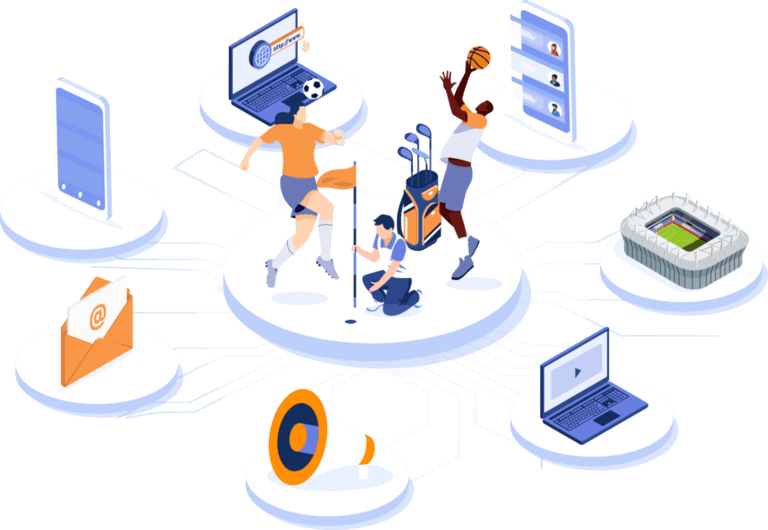
24/7 fan tip 3: Athletes as the main influencers
Today, athletes are considered your 24/7 fans’ top influencers. They are today’s leading indicators of cultural movements. And these movements and changing behaviors are creating new opportunities for athletes to engage their fanbase.
“Athletes are increasingly more important, with a role that is sometimes more prominent in society than the actual organization for which they work”
– Rui Biscaia, university professor and renowned researcher in fan engagement
This is especially true for younger generations Gen Z and Millennials. While older generations usually connect with the teams, the younger generations connect with the players themselves. So to the younger fan crowd, the personal life of the athlete is very important.

To learn more about Gen Z fans, check out this blog post. >>
So, what can your sports organization do to incorporate athletes into your overall strategies? Well, since your fans, especially the younger generation of fans, follow and interact with athletes on social media, then you will need to incorporate:
An influencer strategy for your different athletes.
And here a Sports CDP can help you out. By using insights about your 24/7 fans wants and behaviors, you can create influencer strategies where athletes responds to these wants and behaviors.
For example:
Let’s say several fans want their favorite team to take responsibility for the environment and act. In addition to teams, athletes should also reponds to these desires. And since fans see athletes as more trustworthy than teams, athletes should be considered the main ambassadors for communication such initiatives.
So put together influencer strategies for your top athletes, use the Sports CDP to uncover the insights you need about your fans, and act on these insights via your athletes’ social media channels.

24/7 fan tip 4: Adopting a data-driven culture
When adapting to your 24/7 fans, adopting the right technology, such as Sports CDP, and giving your fans what they want right here and now is only part of the solution. You need to think even bigger. Digitalization will only bring more and more changes that your sports organization will need to adapt to. So how can you ensure that your always prepared and able to serve the 24/7 fan? The answer here is:
By adopting a data-driven culture.
Working data driven simply means making strategic decisions based on the analysis and interpretation of data. And it matters even more now because we are living in the fastest-changing communications technology landscape than ever before. So working data-driven is not something only leading-edge technology companies do. We’re talking about organizations across all industries adopting a data-driven approach.
There are, of course, some challenges that sports organizations face when embarking on their journey to working data-driven, including several of the following:
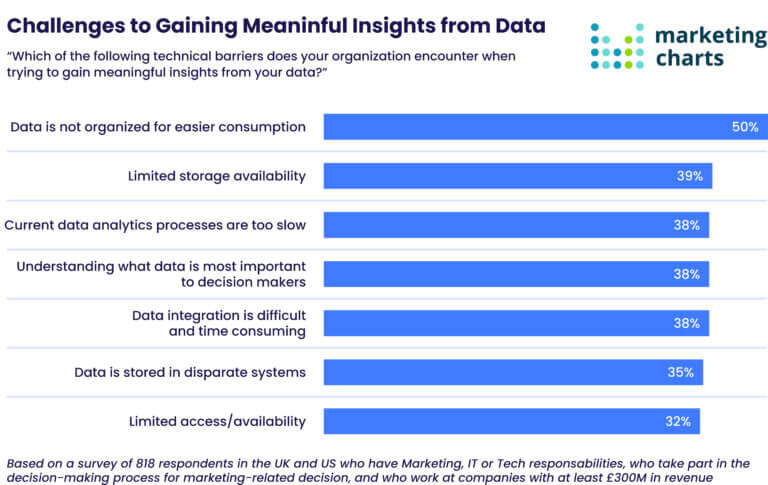
But there is a way you can avoid these challenges. And that is when you use the Data Talks Sports CDP, working data-driven feels like a walk in the park. Because now everyone at your sports organization has access to the same data.What’s more, you’re now able to optimize your decision-making process. This is because you now have the data to guide you on what to do next.
And it gets even better.
Because you can now also work proactively thanks to predictive analytics. This means that you are able to predict your fans’ next moves and leverage AI-based insights, which is crucial if you want to future-proof your sports organization. Amazing, right?
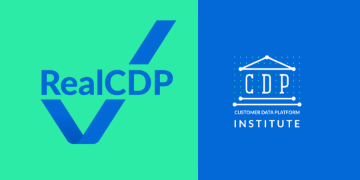
Data Talks CDP is proudly a certified CDP
Conclusion
The 24/7 fan has now become the standard fan. They expect to be able to interact with your sports organization wherever they are and whenever they want. So sports organizations need to adapt to these expectations from fans and overall change in fan behavior. And the key to doing so is having enough insights about what their fans want and desire, including information about their:
- Characteristics
- Preferences
- Behaviors
The challenge, however, is that sports organizations will stumble upon is how to get a hold of all the necessary information about their fans. And this is because all of their fan data is spread out across many different sources. Fortunately, there is a way to not only solve this problem but also streamline and automate it. And that is by using a Sports Customer Data Platform, which has been specifically designed to:
- Collect and unify all of your fan data in one place.
- Analyze it and gain deep insights about your fans, creating a 360-degree view of each fan.
- Act on these insights by delivering hyper-personalized interactions and experiences to each fan.
So how does this look in action? Well, we created a free demo to see all of this and more. So sign up and try it out for yourself. After all, seeing is believing right?
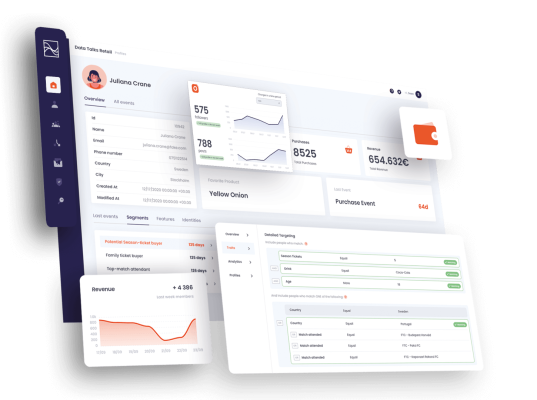
Leave a Reply